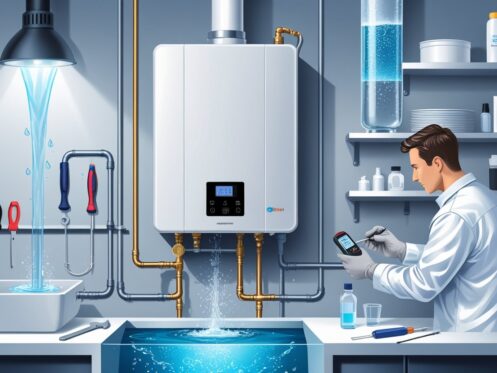A tankless water heater can be a valuable asset in your home, providing hot water on demand and saving space compared to traditional systems. To extend the lifespan of your tankless water heater, regular maintenance and certain proactive measures are essential. By taking care of your unit, you can ensure it operates efficiently and serves you well for years to come.
At Splash Plumbing, we know that simple actions can make a significant difference. Flushing your system annually to remove mineral buildup is one effective method to enhance performance and longevity. Additionally, installing a sediment filter can prevent unwanted debris from affecting water quality, ultimately benefiting your water heater’s functionality.
Taking the time to understand your tankless water heater’s needs can save you from costly repairs down the line. If you’re ready to give your system the care it deserves, consider reaching out to Splash Plumbing for expert advice and services tailored to your unique plumbing situation.
Understanding How Tankless Water Heaters Work
Tankless water heaters provide hot water on demand, using advanced technology and components that differ significantly from traditional tank-style water heaters. Familiarizing yourself with their primary features can enhance your understanding of how to maintain them effectively.
Key Components and Technology
Tankless water heaters consist of several key components. The heating element is essential; it activates when you turn on a hot water faucet, allowing water to flow through a heat exchanger. This design ensures that only the required amount of water is heated at any given time.
Another vital component is the flow sensor, which detects water movement and activates the heating element. The digital thermostat helps in regulating the temperature, ensuring you receive consistent hot water without fluctuations. Tankless water heaters are energy-efficient as they eliminate the need to continuously heat a large volume of water, making them generally more cost-effective over time.
The Differences Between Tankless and Tank-Style Water Heaters
Tank-style water heaters store a significant amount of hot water in a tank, which can lead to energy waste as they maintain heat even when not in use. In contrast, tankless water heaters only heat water when needed, providing endless hot water without the limitations of a storage tank.
Capacity is another significant difference. Tank-based systems typically offer limited hot water supply based on tank size, while tankless systems can provide a continuous flow as long as the heating capacity is not exceeded. This feature is particularly beneficial for larger households or when multiple faucets are used simultaneously.
Splash Plumbing specializes in both types of systems and can help you choose the best option for your hot water needs.
Essential Maintenance Practices for Extended Lifespan
To ensure the longevity and efficient operation of your tankless water heater, regular maintenance is critical. Simple actions can prevent costly repairs and extend the lifespan of your unit. Focus on preventive measures such as flushing, checking components, and scheduling professional inspections.
Regular Flushing to Prevent Sediment Buildup
Sediment buildup can significantly reduce a tankless water heater’s efficiency. Minerals in the water supply can accumulate and cause clogs, leading to reduced heating performance. To avoid this, you should flush the unit at least once a year.
This process involves turning off the water and gas supply, then connecting a flush kit to facilitate the flow of a descaling solution through the system. Follow the manufacturer’s instructions for the correct flushing procedure. Regular flushing helps maintain optimal performance and prolongs the life of your heater.
Checking and Replacing the Pressure Relief Valve
The pressure relief valve is an essential safety feature in a tankless water heater. It helps release excess pressure that builds up within the tank, preventing potential damage. Regularly inspect the valve for any signs of malfunction, such as leaks or corrosion.
If you notice any issues, replacing the valve promptly is crucial to ensure safe operation. A professional plumber can assist with this task, making sure that your system is functioning correctly and efficiently. Regular checks can prevent future complications.
Annual Professional Inspection and Maintenance
Scheduling annual inspections with a professional plumber can greatly enhance the lifespan of your tankless water heater. During these inspections, a qualified technician will assess all components, including the heating elements and electrical connections.
They can identify any potential problems early on and perform necessary maintenance. Professional maintenance may include cleaning, calibrating settings, and ensuring that your heater operates within the manufacturer’s specifications. Trusting these essential tasks to experts from Splash Plumbing ensures a thorough evaluation of your system, keeping it in top condition year after year.
Managing Water Quality to Prevent Damage
Maintaining good water quality is essential for extending the life of your tankless water heater. Various factors, including water hardness and mineral deposits, can significantly affect your system. Understanding these issues can help you implement effective solutions to prevent costly damage.
Understanding the Effects of Hard Water and Mineral Deposits
Hard water contains high levels of dissolved minerals, such as calcium and magnesium. These minerals can lead to mineral buildup and scale buildup in your tankless water heater over time. This accumulation not only impairs efficiency but can also cause corrosion and other forms of damage to internal components.
Symptoms of hard water include reduced water flow and higher energy bills, indicating that your heater might be struggling to operate efficiently. Failing to address these issues promptly can result in premature failure of your unit, making it essential to regularly assess your water quality for hardness.
Using Water Softeners and Filtration Systems
Installing a water softener can significantly reduce the impact of hard water on your tankless water heater. Water softeners work by exchanging calcium and magnesium ions with sodium or potassium ions, effectively reducing mineral content. This process helps prevent scale buildup, leading to improved efficiency and a longer lifespan for your water heater.
In addition to water softeners, incorporating filtration systems can further protect your heater by removing sediment and impurities from your water supply. Look for filters designed to combat specific water quality issues, addressing everything from chlorine to sediment. Consider consulting with a plumbing expert from Splash Plumbing to determine the best system for your needs.
Descaling Using Vinegar and Other Solutions
Regular descaling of your tankless water heater is crucial for preventing mineral deposits and maintaining efficiency. One effective method involves using vinegar, a natural descaling agent. You can schedule a vinegar flush by connecting a pump or using a garden sprayer to circulate the solution through your system.
Alternatively, you may consider commercial descaling solutions available in stores. Always follow the manufacturer’s recommendations for application to avoid damaging your unit. Regular descaling, combined with proper water quality management, will keep your tankless water heater running smoothly, minimizing corrosion and prolonging its service life.
Optimizing Usage and Settings for Maximum Efficiency
To extend the life of your tankless water heater, it’s essential to optimize its usage and settings. By carefully selecting temperature settings, monitoring water pressure, and balancing hot water demand with supply, you can ensure efficient operation and lower energy consumption.
Setting the Right Temperature
Adjusting your water heater’s temperature setting plays a critical role in efficiency. A recommended temperature is around 120 degrees Fahrenheit. This temperature is warm enough for most household needs while preventing scalding. Setting it higher can increase energy consumption and risk damage to your appliance. Using energy-saving modes, if available, can further enhance efficiency. Regularly review your temperature settings, especially during seasonal changes, to maintain optimal performance. Remember, lowering the temperature slightly can lead to savings while still providing sufficient hot water for daily tasks.
Monitoring Water Pressure and Flow Rate
Keeping an eye on water pressure and flow rate is vital for the longevity of your tankless water heater. Ideal water pressure is typically between 40 to 60 psi. Excessively high pressure can strain the system, leading to failures or leaks. You can monitor water pressure using a pressure gauge, which is a simple but effective tool. Additionally, ensure that the flow rate is appropriate for your household’s needs. If you notice fluctuations or drops in pressure, it might be time to inspect your plumbing for blockages or leaks. Maintaining balanced water pressure can help prevent undue stress on the heater and enhance its efficiency.
Balancing Hot Water Demand and Supply
A key factor in tankless water heater efficiency is balancing your hot water demand with available supply. Tankless systems heat water on demand; hence, understanding your household’s average hot water usage is crucial. Schedule high-demand tasks, such as laundry or showering, to avoid simultaneous usage that could overextend your water heater’s capacity. Consider flow restrictors on faucets and showerheads to conserve hot water without sacrificing performance. If your demand outpaces the supply, consult with plumbing experts like Splash Plumbing to explore options for upgrading your system or optimizing your current setup. Balancing these elements can significantly improve efficiency and extend the life of your water heater.
Recognizing Warning Signs and Preventing Costly Repairs
Understanding warning signs can help you maintain your tankless water heater and avoid expensive repairs. Identifying issues in their early stages ensures reliable hot water and maximizes energy efficiency.
Identifying Unusual Noises and Temperature Fluctuations
Pay attention to any strange sounds coming from your tankless water heater. Gurgling, popping, or hissing noises may indicate sediment buildup or mechanical issues. Additionally, temperature fluctuations can signal a failing heating element, affecting efficiency.
If you’re experiencing inconsistent hot water, it could be a sign that your unit needs immediate attention. Regular maintenance checks can catch these problems early, helping you avoid costly repairs down the line.
Spotting Rusty Water or Water Leaks
Rusty water is a clear indicator of corrosion inside your water heater. This issue not only affects the water quality but also signifies potential leaks, which can lead to structural damage in your home.
If you notice water pooling around the unit, it could indicate a serious leak. By addressing these problems promptly, you can save on extensive water damage repairs and ensure your water heater operates efficiently.
Taking Action Against Clogging and Reduced Efficiency
Clogged filters and buildup can significantly reduce your tankless water heater’s efficiency. If you notice a decrease in water pressure or the temperature of your water, it may be due to sediment or mineral deposits obstructing the unit.
Regular descaling and filter cleaning can help maintain optimal performance. By being proactive about these maintenance tasks, you can extend the life expectancy of your heater and achieve better cost savings when it comes to energy bills. For assistance, consider reaching out to Splash Plumbing for expert care.
Insulation and Energy-Saving Strategies
Enhancing the efficiency of your tankless water heater involves effective insulation and energy-saving techniques. Proper insulation minimizes heat loss, leading to cost savings on energy bills and improved system longevity.
Insulating Pipes and Water Heater Components
To maximize energy efficiency, you should consider insulating both the hot water pipes and the tankless water heater itself. Using foam pipe insulation can reduce heat loss significantly. This is especially vital in colder climates where temperature drops can lead to greater energy consumption as the heater works harder to maintain hot water.
Wrap your water heater in an insulated blanket for extra protection. This simple addition can enhance its performance and efficiency. Remember to check that the insulation is compatible with your plumbing system to avoid any issues.
Additionally, if the pipes run through unheated spaces, such as basements or attics, ensure they are well-insulated. By insulating all these components, you create a more energy-efficient system that operates effectively without excessive energy waste.
Reducing Heat Loss for Greater Energy Efficiency
Implementing strategies to reduce heat loss is crucial for your tankless water heater’s performance. One effective method is to reduce the distance between the heater and the hot water outlets. This minimizes heat loss during water transit, enhancing overall energy efficiency.
Consider installing heat traps on your plumbing system. These devices help to keep hot water in the pipes where it belongs, preventing unnecessary cooling before it reaches your fixtures.
Regular maintenance is also key. Periodically check for leaks, as they can lead to significant energy loss. Ensuring that your entire hot water system, including the heater and pipes, is well-maintained will promote optimal energy efficiency. If you need assistance, Splash Plumbing is ready to help you maximize the efficiency of your plumbing system.
Frequently Asked Questions
Understanding how to maintain your tankless water heater can significantly affect its performance and lifespan. Here are some common questions and answers regarding the proper care and maintenance of your unit.
What maintenance procedures should be performed regularly on a tankless water heater to ensure its longevity?
To ensure longevity, perform routine maintenance such as flushing the system annually to remove sediment buildup. Clean or replace the air filter and check for any leaks around the connections. Regularly inspect the heating elements for signs of wear and tear.
Are there specific water filtration systems recommended to prevent mineral buildup in tankless water heaters?
Using a water softener can help reduce mineral buildup, especially in hard water areas. A point-of-use filtration system is also recommended to minimize the amount of sediment entering the water heater. This can prolong the unit’s life and enhance its efficiency.
How often should I descale my tankless water heater to prevent efficiency loss?
Descaling is typically recommended every 6 to 12 months, depending on water hardness. Regular descaling prevents mineral buildup, which can impair efficiency and heating capacity. This maintenance helps avoid costly repairs and extends the unit’s lifespan.
What are the best practices for setting up the temperature on a tankless water heater to reduce wear and tear?
Set the temperature to 120°F (49°C) for optimal efficiency and comfort. Higher temperatures can lead to increased wear and reduce the lifespan of components. Additionally, this setting minimizes the risk of scalding.
Can the installation location of a tankless water heater affect its durability?
Yes, the installation location can influence durability. Ideal locations are dry, well-ventilated areas where the unit is protected from extreme temperatures. Avoid locations prone to moisture or direct sunlight, which can damage the unit over time.
What are the signs of potential issues in tankless water heaters that may indicate the need for immediate maintenance?
Watch for signs like fluctuating water temperatures, unusual noises, or reduced water pressure. Discolored water or a strange smell can also indicate problems. Addressing these issues promptly can prevent more significant damage. If you need assistance, consider contacting Splash Plumbing for professional help.












